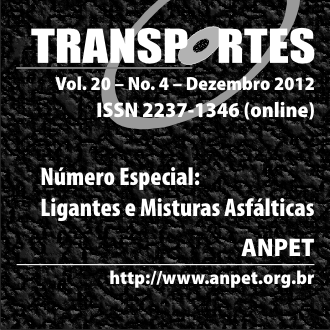Reaproveitamento de areia de fundição residual em misturas de areia asfalto usinada a quente
DOI:
https://doi.org/10.4237/transportes.v20i4.614Abstract
Nos últimos anos, no Brasil, a produção de areia de fundição residual (AFR) tem aumentado em função do desenvolvimento do país. Neste estudo, é analisado o reaproveitamento da AFR em misturas do tipo areia asfalto usinada a quente (AAUQ), para emprego em bases de pavimentos. Misturas com diferentes granulometrias, tipo e teor de ligante asfáltico foram avaliadas através de ensaios de módulo de resiliência, resistência à tração e fluência por compressão uniaxial (creep) estática. Os resultados foram avaliados estatisticamente para determinar a influência dos fatores nos parâmetros estudados. O emprego de ligante asfáltico mais consistente produziu misturas com melhor desempenho. A adição de 10% de agregado fino britado e 3% de cal hidratada, utilizados para modificar a distribuição granulométrica das misturas também melhorou as propriedades avaliadas. De modo geral, conclui-se que as misturas de AAUQ são uma boa alternativa para reaproveitar o resíduo em grandes quantidades.Downloads
References
ABIFA, (2011). Associação brasileira de fundição. www.abifa.org.br. Acessado 01/08/2012.
Akili, W. (1983). On the use of sulphur in sand-asphalt applications. In Journal of the Association of Asphalt Paving Technologists, AAPT. V. 52. pp. 561-584.
Al-Abdul Wahhab, H. I., Asi, I. M. (1997). Improvement of marl and dune sand for highway construction in arid areas. In Building and Environment: Vol. 32, No. 3, pp. 271-279.
Aldigueri, D.R. (2001). Estudo de Misturas de Areia Asfalto Usinadas a Quente com asfaltos de diferentes consistências para revestimento de pavimentos no Estado do Ceará. Dissertação de Mestrado. Universidade de São Paulo, São Paulo.
Barksdale, R. D. (1980). Construction and performance of sand-asphalt bases. Transportation Research Record, No. 741, pp. 13-22. Washington, D.C. Estados Unidos da América.
Bernucci, L. B.; Motta, L. M. G. da; Ceratti, J. A. P.; Soares, J. B. (2008). Pavimentação Asfáltica, Formação básica para engenheiros. Petrobras, ABEDA. Rio de Janeiro.
BNDES (2011). Indústria de fundição: situação atual e perspectivas. Arquivo digital do BNDES Setorial 33, p. 121-162.
Bonet, I.I. (2002). Valorização do resíduo de areia de fundição (RAF). Incorporação nas massas asfálticas do tipo C.B.U.Q. Dissertação (Mestrado) – Universidade Federal de Santa Catarina – Santa Catarina.
Costa, C. J. B. da. (2008). Mistura asfáltica com uso de areia de fundição de ferro descartada. Dissertação (Mestrado) – Instituto Militar de Engenharia – Rio de Janeiro.
Coutinho Neto, B. (2004). Avaliação do reaproveitamento de areia de fundição como agregado em misturas asfálticas densas. Tese (Doutorado) – Escola de Engenharia de São Carlos – Universidade de São Paulo. São Paulo.
Coutinho Neto, B. ; Fabbri, G. T. P. . Ensaio de fluência uniaxial estático - avaliação do efeito devido à redução do diâmetro do prato devido à aplicação de carga. In: XVIII Congresso de Pesquisa e Ensino em Transportes, 2004, Florianópolis - SC. Panorama Nacional da Pesquisa em Transportes 2004. Rio de Janeiro - RJ: Associação nacional de Pesquisa e Ensino em Transportes, 2004. v. Único. p. 127-137.
Coz, A. F. (2001). Comportamento ambiental de lodos de fundición estabilizados/solidificados. Tese de Doutorado. Universidade de Cantabria. Santander. España.
De Hilster, E. e P. J. Van de Loo (1977) The creep test: influence of teste parameters. Report, Shell Laboratories, Amsterdam, The Netherlands.
DNIT 032/2005 – ES. Pavimentos flexíveis – Areia Asfalto a quente – Especificação de serviço. Departamento Nacional de Infra-Estrutura de Transportes. Rio de Janeiro, RJ.
DER-SP. (2006). Projeto de pavimentação. Instrução de Projeto. IP-DE-P00/001. São Paulo, SP.
Edil, t. B.; Benson, g. H. (2005). Field Performance of Sub-Bases Constructed with Industrial Byproducts and Geosynthetic Reinforcement. Final Report. Wisconsin Highway Research Program # 0092-45-18. University of Wisconsin-Madison, United States.
Fatani, M. N. e Sultan, H. A. (1982). Dune sand-aggregate mixes and dune sand-sulfur mixes for asphalt concrete pavements.. Transportation Research Record, No. 843, pp. 72-79. Washington, D.C. Estados Unidos da América.
Hills, J. F. (1973) The creep of asphalt mixes. Journal of the Institute of Petroleum, vol. 59, n. 570, p. 247-262.
Javed, S.; Lovell, C.W. (1995). Uses of Waste Foundry Sands in Civil Engineering. Transportation Research Board, n. 1417, p. 109-116.
Klinsky, L. M. G. e Fabbri, G. T. P. (2009). Reaproveitamento da areia de fundição como material de base e sub-base de pavimentos flexíveis. Revista Transportes. V. 17. N. 2. pp. 36-45. Rio de Janeiro, RJ.
Krukar, M. e Cook, J. C. (1970). Experimental Ring No. 4: A study of untreated, sand asphalt and asphalt concrete bases. Report to the Washington Department of Higways on Research Project Y-993. Washington D.C. Estados Unidos da América.
Little, N. D.; J. W. Button e H. Youssef (1993) Development of criteria to evaluate uniaxial creep data and asphalt concrete permanent deformation potential. Transportation Research Record, n. 1417, p. 49-57.
Little, N. D. (1999). Evaluation of structural properties of lime stabilized soils and aggregates. Volume 1: Summary of findings. National Lime Association. Estados Unidos.
Mazumdar, M. e Rao, S. K. (1985). Effect of comparative efforts on sand-asphalt-sulphur mixes. In Canadian Journal of Civil Engineering: Vol. 12, No. 4, pp 916-919.
Mcintyre, S.W., Rundman, K.B., Baillod, C. R., Rush, P., Sandell, J., Stillwell, B. (1992). Beneficiation and Reuse of Foundry Sand Residuals: A Preliminary Report. Transactions of the American Foundry men’s Society, vol. 100, p.201-208.
Partridge, B.K.; Fox, P. J.; Alleman, J. E. e Mast, D. C. (1999). Field Demonstration of Highway Embankment Construction Using Waste Foundry Sand. Transportation Research Record, n. 1670, p. 98-105.
Potts, C. F., Ruth, B. E., Smith, L. L. (1980). Performance of Sand-Asphalt and Limerock Pavements in Florida. In Transportation Research Record. V. 741. pp 22-34. Washington D. C.
Valkering, C. P.; D. J. L. Lancon;. E. de Hilster e D. A. Stoker (1990) Rutting resistance of asphalt mixes containing non-conventional and polymer-modified binders. Symposium – Improved Rut Resistance, Association of Asphalt Paving Technologists (AAPT), Proceedings, p. 590-609.
Van de Loo, P. J. (1974) Creep testing, a simple tool to judge asphalt mix stability. Association of Asphalt Paving Technologists (AAPT), Proceedings, vol. 43, p. 117-153.
Walker, F. K., Hicks, R. G. (1976). The use of sand asphalt in highway construction. In Journal of the Association of Asphalt Paving Technologists, AAPT. V. 45. pp. 429-452.
Warden, W. B., Hudson, S.B. (1960). Hot-mixed black base construction using natural aggregate. In Journal of the Association of Asphalt Paving Technologists, AAPT. V. 30. pp. 291-307.
Downloads
Published
How to Cite
Issue
Section
License
Authors who submit papers for publication by TRANSPORTES agree to the following terms:
- The authors retain the copyright and grant Transportes the right of first publication of the manuscript, without any financial charge, and waive any other remuneration for its publication by ANPET.
- Upon publication by Transportes, the manuscript is automatically licensed under the Creative Commons License CC BY 4.0 license. This license permits the work to be shared with proper attribution to the authors and its original publication in this journal, and to be adapted for non-commercial purposes, provided appropriate credit is given and any derivative works are distributed under the same terms.
- Authors are authorized to enter into additional separate contracts for the non-exclusive distribution of the version of the manuscript published in this journal (e.g., publishing in an institutional repository or as a book chapter), with recognition of the initial publication in this journal, provided that such a contract does not imply an endorsement of the content of the manuscript or the new medium by ANPET.
- Authors are permitted and encouraged to publish and distribute their work online (e.g., in institutional repositories or on their personal websites) after the editorial process is complete. As Transportes provides open access to all published issues, authors are encouraged to use links to the DOI of their article in these cases.
- Authors guarantee that they have obtained the necessary authorization from their employers for the transfer of rights under this agreement, if these employers hold any copyright over the manuscript. Additionally, authors assume all responsibility for any copyright infringements by these employers, releasing ANPET and Transportes from any responsibility in this regard.
- Authors assume full responsibility for the content of the manuscript, including the necessary and appropriate authorizations for the disclosure of collected data and obtained results, releasing ANPET and Transportes from any responsibility in this regard.









